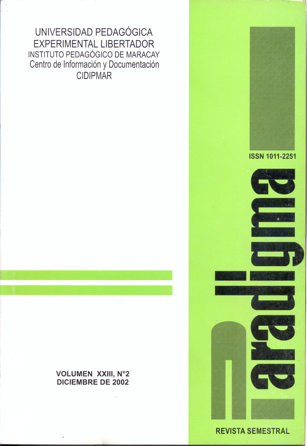LOS ELEMENTOS DE ANÁLISIS TRASCENDENTE DE FRANCISCO DÍAZ COVARRUBIAS Debate en México (1870) sobre los fundamentos del Cálculo Infinitesimal. Entre la sencillez y el rigor
DOI:
10.37618/PARADIGMA.1011-2251.2002.p123-157.id282Resumen
RESUMENA pesar de su atemporalidad, los Elementos de Análisis Trascendente del ingeniero mexicano Francisco Díaz Covarrubias (1833-1889) han sido leídos y usados por generaciones de estudiantes e ingenieros a lo largo de 130 años lo cual ha conformado una tradición. Ello ha sido posible gracias al modelo pragmático con que fue construido el texto. Fincado en un estilo algebraico a partir de evitar toda consideración de límites y cantidades infinitesimales o evanescentes en tanto reducir el estudio de los fenómenos físicos a otro u otros que le sean en menor grado, usando para ello medios auxiliares e indirectos que evitarían los pasos al límite y consecuentemente al infinito. Presentamos aquí un análisis del Cálculo de Díaz Covarrubias desde dos perspectivas: Primero, aquella de la Elementarización; es decir, el modelo cultural para la escritura de textos de matemáticas que llevó al autor a la modificación de los conceptos del Cálculo, con argumentos sencillos y precisos, estandarizándoles para su aprendizaje en los estudiantes de la Escuela Nacional Preparatoria y, segundo, a partir del debate entre positivistas que se dio durante el último tercio del siglo XIX por la definición de los fundamentos del Cálculo entre el propio Díaz Covarrubias y el filósofo mexicano, contemporáneo a éste, Gabino Barreda. Con el análisis intentamos mirar hacia el pensamiento que el autor refleja en su obraDescriptores: Historia de la Matemática, Enseñanza del Cálculo, Matemática Educativa.ABSTRACTIn spite of its anachronism, the Elementos de Analisis Trascendente of the Mexican engineer Francisco Diaz Covarrubias (1833-1889) they have been read and used by students and engineer generations throughout 130 something which years to certify a tradition. This has been possible thanks to the pragmatic model with which was built the text. This was built in an algebraic style as of avoid all limits consideration and infinitesimal quantities or evanesces in so much to reduce the study of the physical phenomena to other or other that to him will be in smaller degree. Using for this means auxiliary and indirect that would avoid the steps to the limit and consequently to the infinite. We present here an analysis of the calculation of Diaz Covarrubias from two perspectives: First, that of the elementarization; that is to say, the cultural model for the writing of mathematics texts that I carry to the author to the modification of the concepts of the calculation, whit simple and accurate arguments, standardizing for their learning in the students of the Preparatory National School and, second, starting from discussion between positivists that was given during the last third of the century XIX by the definition of the bases of the calculation between the own Diaz Covarrubias and a Mexican philosopher, contemporary to this, Gabino Barreda, whit analysis we attempt to watch toward the thought of the author that appears in the work.Key Words: Mathematics’s history, Calculus’s Teaching, Mathematics education.Descargas
Los datos de descargas todavía no están disponibles.
Descargas
Publicado
18-11-2015
Métricas
Visualizações do artigo: 55 PDF downloads: 23
Cómo citar
Camacho (ITCHIHUAHUAII, Chihuahua--México), A. (2015). LOS ELEMENTOS DE ANÁLISIS TRASCENDENTE DE FRANCISCO DÍAZ COVARRUBIAS Debate en México (1870) sobre los fundamentos del Cálculo Infinitesimal. Entre la sencillez y el rigor. PARADIGMA, 23(2), 123–157. https://doi.org/10.37618/PARADIGMA.1011-2251.2002.p123-157.id282
Número
Sección
Artículos


 English
English
 Español (España)
Español (España)
 Français (France)
Français (France)
 Português (Brasil)
Português (Brasil)




















































